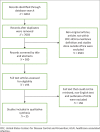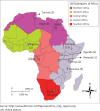A systematic review of healthcare-associated infections in Africa: An antimicrobial resistance perspective
- PMID: 30568902
- PMCID: PMC6296034
- DOI: 10.4102/ajlm.v7i2.796
A systematic review of healthcare-associated infections in Africa: An antimicrobial resistance perspective
Abstract
Background: Healthcare-associated infection (HCAI) is a global health challenge, not only as an issue of patient safety but also as a major driver of antimicrobial resistance (AMR). It is a major cause of morbidity and mortality with economic consequences.
Objective: This review provides an update on the occurrence of HCAI, as well as the contribution of emerging AMR on healthcare delivery in Africa.
Methods: We searched PubMed, Cochrane database, African Journals Online and Google Scholar for relevant articles on HCAI in Africa between 2010 and 2017. Preferred reporting items of systematic reviews and meta-analyses guidelines were followed for selection. Thirty-five eligible articles were considered for the qualitative synthesis.
Results: Of the 35 eligible articles, more than half (n = 21, 60%) were from East Africa. Klebsiella spp., Staphylococcus aureus, Escherichia coli and Pseudomonas spp. were the common pathogens reported in bloodstream infection, (catheter-associated) urinary tract infection, surgical site infection and healthcare-associated pneumonia. Among these various subtypes of HCAI, methicillin-resistant S. aureus (3.9% - 56.8%) and extended-spectrum beta-lactamase producing Gram-negative bacilli (1.9% - 53.0%) were the most reported antimicrobial resistant pathogens.
Conclusion: This review shows a paucity of HCAI surveillance in Africa and an emergence of AMR priority pathogens. Hence, there is a need for a coordinated national and regional surveillance of both HCAI and AMR in Africa.
Conflict of interest statement
The authors declare that they have no financial or personal relationships which may have inappropriately influenced them in writing this article.
Figures
References
-
- World Health Organization Antimicrobial resistance. [homepage on the Internet]. Vol. 61, Bull World Health Organ; 2014. [cited 2017 February 5]; Available from: http://www.ncbi.nlm.nih.gov/pubmed/22247201
-
- O’Neill J. Tackling drug-resistant infections globally: Final report and recommendations the review on antimicrobial resistance. London: Wellcome Trust; 2016.
-
- Allegranzi B, Pittet D. Preventing infections acquired during health-care delivery. Lancet. 2008;372:1719–20. https://doi.org/10.1016/S0140-6736(08)61715-8 - DOI - PubMed
-
- Archibald L, Jarvis W. Incidence and nature of endemic and epidemic healthcare-associated infections. 5th ed. J W., editor. Hospital infections. Philadelphia, PA: Lippincott Williams & Wilkins; 2007.
-
- Pittet D, Donaldson L. Clean care is safer care: A worldwide priority. Lancet. 2005;366:1246–7. https://doi.org/10.1016/S0140-6736(05)67506-X - DOI - PMC - PubMed
Publication types
LinkOut - more resources
Full Text Sources
Miscellaneous



